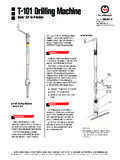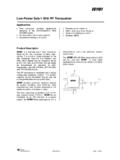Transcription of Common Coaxial Connectors - Davis RF
1 Common Coaxial Connectors Below, I present a digest of important information about Coaxial Connectors . Most of these are for RF and microwave frequencies, but a few of the more Common ones used for lower frequencies are included for completeness. Why different Connectors ? Many Coaxial connector types are available in the audio, video, digital, RF and microwave industries, each designed for a specific purpose and application. Much of the development of the smaller Connectors that perform well into the GHz and millimeter wave range has been conducted by test equipment measurement companies. One of their considerations is the number of connect-disconnect cycles that a connector pair can withstand while still performing as expected. Why different sizes and frequencies? The frequency range of any connector is limited by the excitation of the first circular waveguide propagation mode in the Coaxial structure.
2 Decreasing the diameter of the outer conductor increases the highest usable frequency. Filling the airspace with dielectric lowers the highest frequency and increases losses. The mating process typically changes the geometry of the mating surfaces and resistance loss at those interfaces as well as geometric changes result in variation of impedance and loss. Some RF Connectors are sexless (such as the HP/Amphenol APC-7 and the General Radio GR874 and GR900BT). Most Connectors have female structures with slotted fingers that introduce a small inductance. The fingers accommodate tolerance variations, but reduce repeatability and may ultimately break after 1000 connections. There are slotless versions of Connectors available, but they are, for the most part, relegated to instrument interfaces.
3 Slotless female Connectors are very difficult to clean and require very careful connection and disconnection. Sex and Connectors Those unaccustomed to the use of the terms "male" and "female" to describe Connectors will have to get used to this time-honored engineering nomenclature. Those of us who work with them regularly use the terminology without a second thought. One day a number of years back, my daughter (who was about 8 years old at the time, if memory serves) was in the lab with me while I was working at the network analyzer with one of the grad students. She overheard our conversation, peppered as it was with the terms "male connector" and "female connector". After we were done, she asked me why the Connectors were named that way. Well, this was a conversation I had expected to have in somewhat different circumstances, but I gave her a quick summary of the "how-babies-get-made" story, followed by the analogy that is implied by the connector terminology.
4 She thought about it for a few moments when I was done, and then said, "Daddy, that's just weird." It's hard to argue with that. Connecting and Disconnecting RF and microwave Connectors are precision-made parts, and can be easily damaged by mistreatment. You should start with all connector surfaces as clean as possible, using a solvent such as alcohol or a special-purpose cleaner to do the job. Use as little as you can, and in no event contact dielectric spacers or resistive materials (as used in loads). with the solvent, since these can be irreparably damaged by the solvent. As a general rule, if the Connectors have threaded sleeves, you should rotate these to tighten, leaving the rest of the connector (and cable) stationary. If other parts of the connector are twisted while tightening or loosening, damage can easily occur.
5 Connecting 7 mm Connectors is somewhat different, and perhaps counterintuitive. These are sexless Connectors , and the mating surfaces mount flush and are held together by a single rotating sleeve. The mating sequence is: 1. Each connector has an outside rotating sleeve. On one connector, rotate the outer sleeve so that the threaded connector sleeve extends completely out from the outer sleeve. Do this on any fixed-mounted Connectors , such as those on the test ports of a network analyzer. On the other connector, rotate the outer sleeve so that the threaded connector sleeve recedes completely into the outer sleeve. 2. Mate the surfaces flush and rotate the forward sleeve to engage the threads of the other connector. 3. Complete connection is made when the forward rotating sleeve is tight and the other sleeve is loose.
6 Caution: one sleeve must be loose. Tightening down both sleeves can cause connector damage. Coaxial CONNECTOR CHART. Other Connector names Maximum Female Male Type (or mates Frequency with). 100 kHz TS, TRS. or less Phone Ever see those old telephone switchboards with hundreds of jacks and patch plugs cords and plugs? Those are phone jacks and plugs, also known as TS (Tip- and jacks Sleeve) for two-conductor connections, or TRS (Tip-Ring-Sleeve) for three- conductor connections. They are now used widely with musical instruments and audio equipment. The phone plug is the male connector, a phone jack is the female connector. The standard diameter of the plug is ", but many smaller sizes are available as well. These are really only suitable for audio frequencies. Phono plugs 10 MHz and jacks RCA.
7 A round, press-on connector commonly used for consumer-grade audio and composite video connections. In most recent home stereo equipment, the jacks are color-coded as follows: red (audio-Right), black or white (audio-Left). and yellow (composite video). Generally not a constant characteristic impedance connector. PL-259. (male), 300 MHz SO-239 or less (female). The UHF type connector saw its conception in the early 1930's, a time when VHF/UHF technology was quite new. The forefathers of VHF were in many cases Amateur radio experimenters, most with Engineering and technical backgrounds. They began experimenting and working the VHF frontier around UHF 1926. Soon thereafter research into FM radio and Television began and out of this era came the then named UHF connector. Manufacturers of UHF plugs and receptors all state that this type connector are of generally non-constant (characteristic) impedance and are suitable for use up to 200 or 300 MHz only, depending on production quality.
8 They also state that the UHF. connector can be used up to 500 MHz with a cautionary note of reduced performance. The so named UHF connector from the past is not really suitable for use above 300 MHz at all. Perhaps the exception to this would be when a cheap and rugged system is required where loss and good signal to noise ratio is of little concern. However, even for frequencies as low as 144 MHz, if low loss and good signal to noise ratio are very desirable, the use of UHF type Connectors is not recommended. The UHF connector still has a place in many applications where a robust but economical RF connector is required, but for serious applications its use should be limited to below 100 MHz. The N type is far superior in performance, and it should also be noted the BNC type connector is similar in performance to the N type, but has the disadvantage of being less rugged.
9 250 MHz Video to 1 GHz F. The F series Connectors are primarily utilized in television cable and antenna applications. Normally these are used at 75 ohm characteristic impedance. 3/8-32 coupling thread is standard, but push-on designs are also available. 2 GHz or higher BNC The "Bayonet Neil-Concelman" or "Bayonet Navy Connector" or "Baby Neil Connector", depending on the information source. Karl W. Concelman is believed to have created the "C" connector. The BNC was designed for military use and has gained wide acceptance in video and RF applications to 2. GHz. The BNC uses a slotted outer conductor and some plastic dielectric on each gender connector. This dielectric causes increasing losses at higher frequencies. Above 4 GHz, the slots may radiate signals, so the connector is usable, but not necessarily mechanically stable up to about 10 GHz.
10 Both 50. ohm and 75 ohm versions are available. 2 GHz or TNC. higher A threaded version of the BNC connector. It helps resolve leakage and geometric stability problems, permitting applications up to 12 GHz. The specifications for N, BNC and TNC Connectors are found in MIL-C-39012. There are special "extended frequency" versions of the TNC that adhere to the IEC 169-17 specification for operation to 11 GHz or 16 GHz, and the IEC. 169-26 specification that operate mode-free to 18 Ghz (but with significant losses). The TNC connector is in wide use in cellular telephone RF/antenna connections. Because the mating geometries are compatible with the N. connector, it is possible to temporarily mate some gender combinations of BNC and N. This is not a recommended use because the connection is not mechanically stable, and there will be significant impedance changes at the interface.









